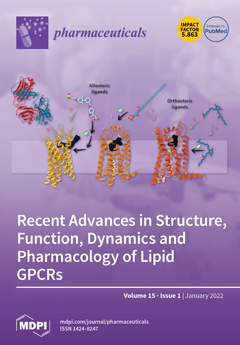E. coli is a Gram-negative bacterium that causes different human infections. Additionally, it resists common antibiotics due to its outer protective membrane. Natural products have been proven to be efficient antibiotics. However, plant natural products are far less explored in this regard. Accordingly, over 16,000 structures covering almost all African medicinal plants in AfroDb in a structural-based virtual screening were used to find efficient anti-
E. coli candidates. These drug-like structures were docked into the active sites of two important molecular targets (i.e.,
E. coli’s Ddl-B and Gyr-B). The top-scoring hits (i.e., got docking scores < −10 kcal/mol) produced in the initial virtual screening (0.15% of the database structures for Ddl-B and 0.17% of the database structures for Gyr-B in the database) were further refined using molecular dynamic simulation-based binding free energy (Δ
G) calculation. Anthraquinones were found to prevail among the retrieved hits. Accordingly, readily available anthraquinone derivatives (10 hits) were selected, prepared, and tested in vitro against Ddl-B, Gyr-B, multidrug-resistant (MDR)
E. coli, MRSA, and VRSA. A number of the tested derivatives demonstrated strong micromolar enzyme inhibition and antibacterial activity against
E. coli, MRSA, and VRSA, with MIC values ranging from 2 to 64 µg/mL. Moreover, both
E. coli’s Ddl-B and Gyr-B were inhibited by emodin and chrysophanol with IC
50 values comparable to the reference inhibitors (IC
50 = 216 ± 5.6, 236 ± 8.9 and 0.81 ± 0.3, 1.5 ± 0.5 µM for Ddl-B and Gyr-B, respectively). All of the active antibacterial anthraquinone hits showed low to moderate cellular cytotoxicity (CC
50 > 50 µM) against human normal fibroblasts (WI-38). Furthermore, molecular dynamic simulation (MDS) experiments were carried out to reveal the binding modes of these inhibitors inside the active site of each enzyme. The findings presented in this study are regarded as a significant step toward developing novel antibacterial agents against MDR strains.
Full article






